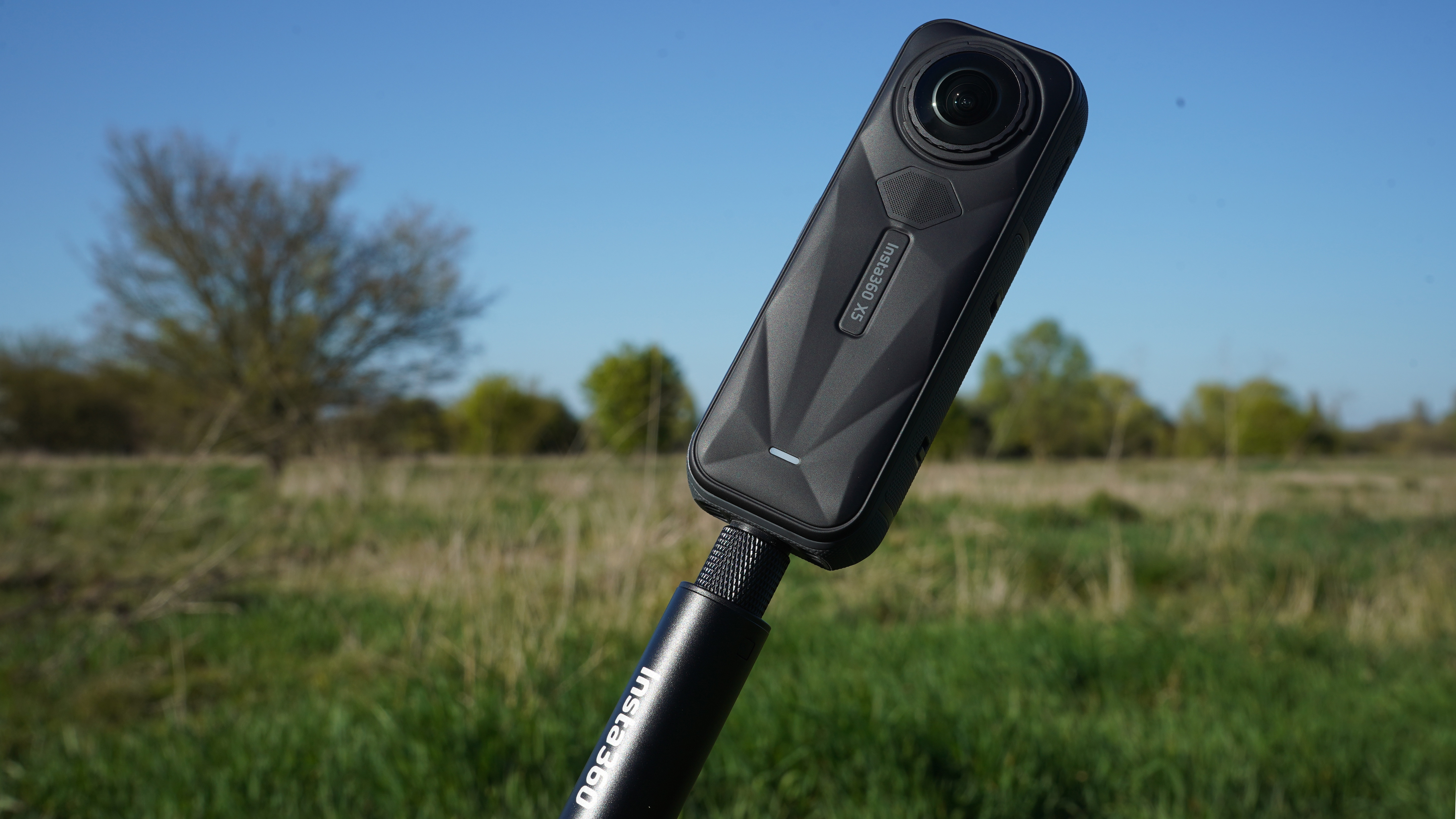First 5 James Webb Telescope images revealed by NASA will blow your mind
NASA and President Joe Biden have already unveiled the first James Webb Telescope image but there are more to come
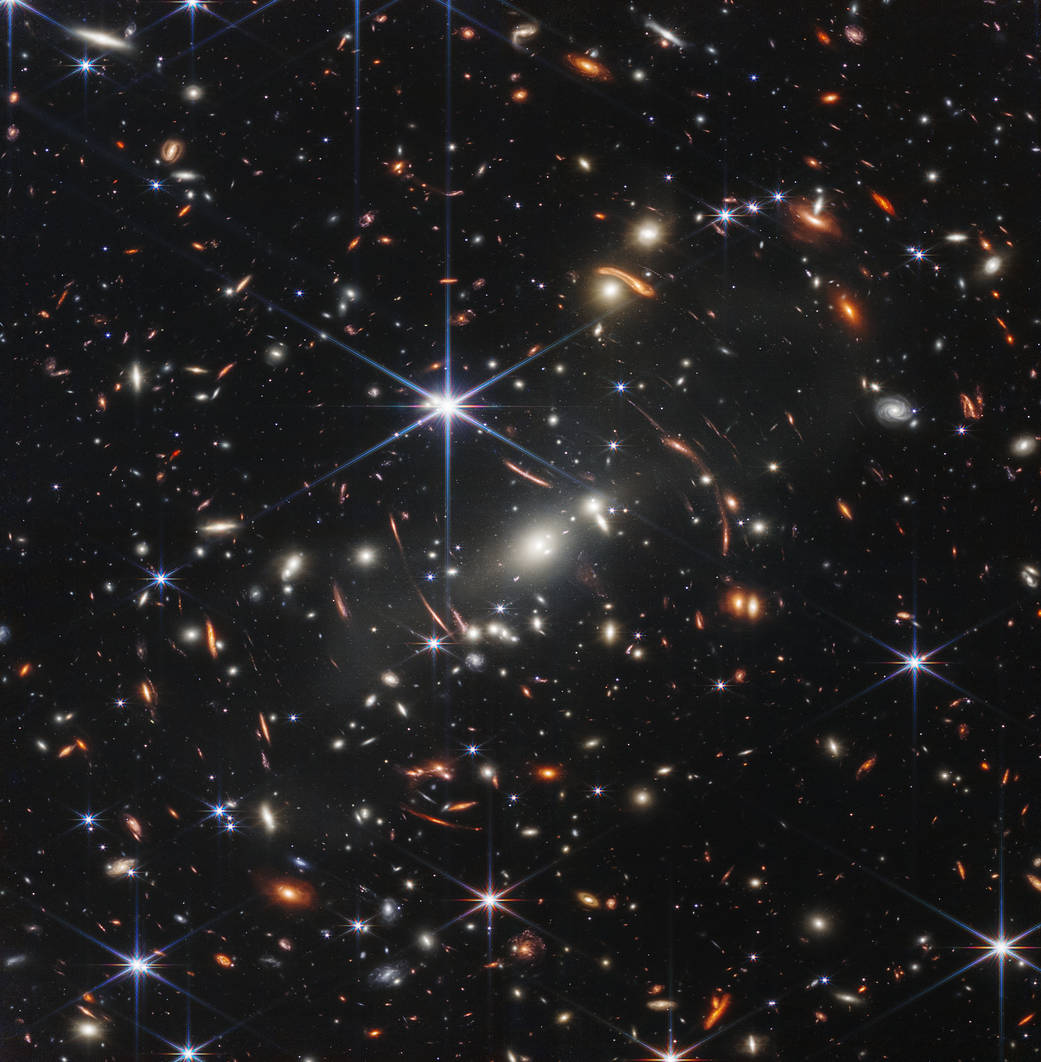
The time has finally come... like Christmas day for the astronomy community, NASA will today share with the world one of the anticipated first-ever images produced by the newly launched James Webb Space Telescope (JWST)!
US President Joe Biden has released one of Webb’s first images in a live stream preview event directly from the White House in Washington.
This is just the very beginning of what we can expect on Tuesday 12 July at 07:30 PT / 10:30 ET / 15:30 BST as all images from the JWST will be unveiled by NASA live for the world to see.
We're about to observe the universe as we've never experienced it before, a new worldview into the cosmos. Join us as we watch live the unveiling of a whole new perspective of space, a golden age in our universal understanding, and witness the first-light image release, captured by the most powerful telescope and space observatory ever to be launched into space.
First Images from the James Webb Space Telescope revealed
President Joe Biden has already released one of the James Webb Space Telescope’s first images, and we're astounded at what we're seeing!
The first image from NASA’s James Webb Space Telescope is the deepest and sharpest infrared image of the distant universe to date. According to NASA "thousands of galaxies – including the faintest objects ever observed in the infrared – have appeared in Webb’s view for the first time. This slice of the vast universe covers a patch of sky approximately the size of a grain of sand held at arm’s length by someone on the ground."

👀 Sneak a peek at the deepest & sharpest infrared image of the early universe ever taken — all in a day’s work for the Webb telescope. (Literally, capturing it took less than a day!) This is Webb’s first image released as we begin to #UnfoldTheUniverse: https://t.co/tlougFWg8B pic.twitter.com/Y7ebmQwT7jJuly 11, 2022
• Read more:
Best telescopes for astrophotography
Best star tracker camera mounts
Best lenses for astrophotography
NASA scientists have already seen the images that will be released today and tomorrow - and as we reported last week, almost moving them to tears, we are told.
NASA’s deputy administrator, Pam Melroy, said "What I have seen moved me, as a scientist, as an engineer, and as a human being.”
On Friday last week, NASA revealed a list of the initial images that have been photographed with the new space telescope. These will include:
Carina Nebula: The Carina Nebula is one of the largest and brightest nebulae in the sky, located approximately 7,600 light-years away in the southern constellation Carina. Nebulae are stellar nurseries where stars form. The Carina Nebula is home to many massive stars, several times larger than the Sun.
WASP-96 b (spectrum): WASP-96 b is a giant planet outside our solar system, composed mainly of gas. The planet, located nearly 1,150 light-years from Earth, orbits its star every 3.4 days. It has about half the mass of Jupiter, and its discovery was announced in 2014.
Southern Ring Nebula: The Southern Ring, or “Eight-Burst” nebula, is a planetary nebula – an expanding cloud of gas, surrounding a dying star. It is nearly half a light-year in diameter and is located approximately 2,000 light years away from Earth.
Stephan’s Quintet: About 290 million light-years away, Stephan’s Quintet is located in the constellation Pegasus. It is notable for being the first compact galaxy group ever discovered in 1877. Four of the five galaxies within the quintet are locked in a cosmic dance of repeated close encounters.
SMACS 0723: Massive foreground galaxy clusters magnify and distort the light of objects behind them, permitting a deep field view into both the extremely distant and intrinsically faint galaxy populations.
NASA's tweet announcing the times of the full reveal of the JWST images…
The wait is almost over! 🌟 The full set of Webb's first images & data will be revealed in less than 2 days. On July 12, watch our broadcast LIVE at 10:30 am ET (14:30 UTC) on any of @NASA’s streaming platforms, including Twitter. Count down with us: https://t.co/CfvDXKW8hG pic.twitter.com/mTnLs8ofdvJuly 11, 2022
This is NASA's official timeline for the announcements for today and tomorrow (times are are Eastern Time):
Monday, July 11
5 p.m. – President Joe Biden will release one of Webb’s first images in a preview event at the White House in Washington. NASA Administrator Bill Nelson will provide remarks. A live stream of the event will be available on NASA TV. The image will be available simultaneously on NASA’s website.
Tuesday, July 12 (Image Release Day)
9:45 a.m. – Live, opening remarks by agency and Webb leadership will air on NASA TV, the NASA app, and the agency’s website ahead of the first images release.
10:30 a.m. – Live coverage of the image release broadcast will air on NASA TV, the NASA app, and the agency’s website. The public also can watch live on Facebook, Twitter, YouTube, Twitch, and Daily Motion.
12:30 p.m. – Following the live broadcast, NASA and its partners will hold a joint media briefing at NASA Goddard. The briefing will livestream on NASA TV, the NASA app, and the agency’s website. Participants include:
This is the YouTube channel where you can watch Joe Biden show the first JWST image later today
Nearly time for the sneak peak…
So we are still waiting for POTUS to show us the first image - we are now told it will be at 5.30pm ET (10.30pm BST) - half an hour later than expected...
Still waiting... NASA TV has been saying the White House briefing will begin momentarily for around 10 minutes so far. But with the promise of seeing millions of years into the past of the universe, we expect it is worth the wait
We are live now with the Vice President
Joe Biden is now on screen, after the intro from Kamala Harris
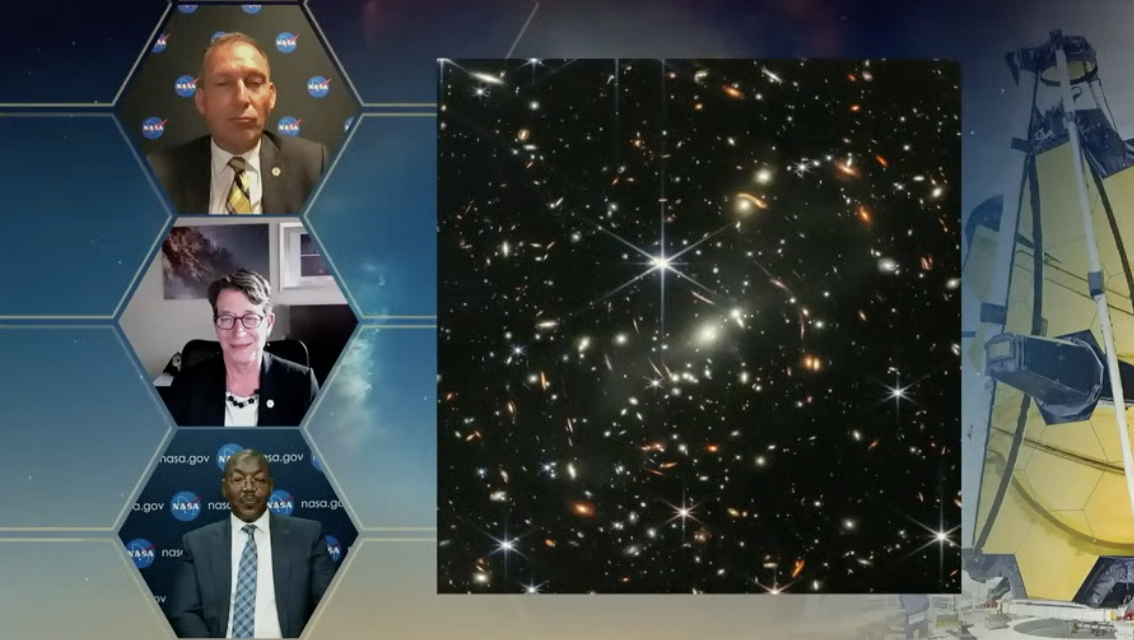
This is the image we have been waiting for... an image that is 13 billion years in the making.
This deep field, taken by Webb’s Near-Infrared Camera (NIRCam), is a composite made from images at different wavelengths, totaling 12.5 hours – achieving depths at infrared wavelengths beyond the Hubble Space Telescope’s deepest fields, which took weeks.
The image shows the galaxy cluster SMACS 0723 as it appeared 4.6 billion years ago. The combined mass of this galaxy cluster acts as a gravitational lens, magnifying much more distant galaxies behind it. Webb’s NIRCam has brought those distant galaxies into sharp focus – they have tiny, faint structures that have never been seen before, including star clusters and diffuse features. Researchers will soon begin to learn more about the galaxies’ masses, ages, histories, and compositions, as Webb seeks the earliest galaxies in the universe.
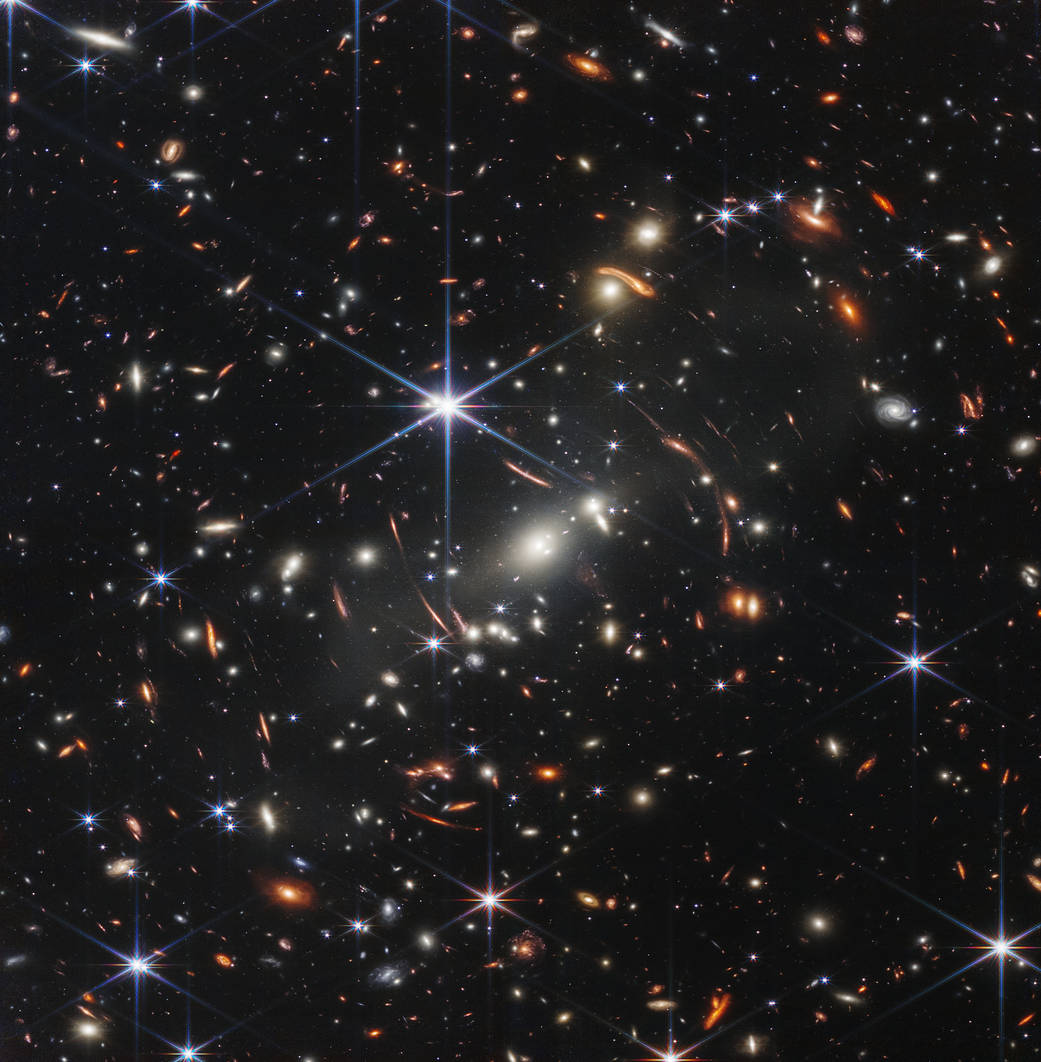
It's finally image release day! NASA will very soon be giving us a live image release broadcast with the very first images from the James Webb Space Telescope (JWST), which you can watch on NASA TV, the NASA app, and the agency’s website.
If that wasn't enough outlets, you can also watch the event live on Facebook, Twitter and YouTube.
Remember, this telescope is special, as it's sharp near-infrared view can bring out even the faintest structures in galaxies far, far away, and offer the most detailed view of the early universe to date – EVER.
So far, we've only seen one image so far (shown below), as that is the only picture that NASA has teased us with to build the excitement. It was shared with the whole world yesterday in a live broadcast with US President Joe Biden.

NASA has shared plenty of information about this first image from the James Webb Space Telescope, which is neatly titled Webb’s First Deep Field.
It's an image of a galaxy cluster SMACS 0723 as it appeared 4.6 billion years ago, and it's not one image but rather a composite made from images at different wavelengths, totaling 12.5 hours – achieving depths at infrared wavelengths beyond the Hubble Space Telescope’s deepest fields, which took not days, but weeks!
NASA adds, "the image covers a patch of sky approximately the size of a grain of sand held at arm’s length by someone on the ground – and reveals thousands of galaxies in a tiny sliver of vast universe."
What time do we expect the next images to be released?
According to the official NASA schedule, we expect the first full set of images from the James Webb Space Telescope – "the largest, most powerful and complex space science telescope ever built" – to be released today, July 12, 2022.
The following timings are EST, so if you're not in that time zone you'll have to adjust.
9:45 a.m. – We can expect opening comments from the Webb leadership to air on NASA TV and the NASA app, ahead of the first images release.
10:30 a.m. – Live coverage of the image release broadcast will air on NASA TV, the NASA app, and the agency’s website and on Facebook, Twitter and YouTube.
12:30 p.m. – Following the live broadcast, NASA and its partners are set to hold a joint media briefing at NASA Goddard. This briefing will livestream and include interviews with key project scientists who have worked on the telescope.
Where can I see the first images as they are released?
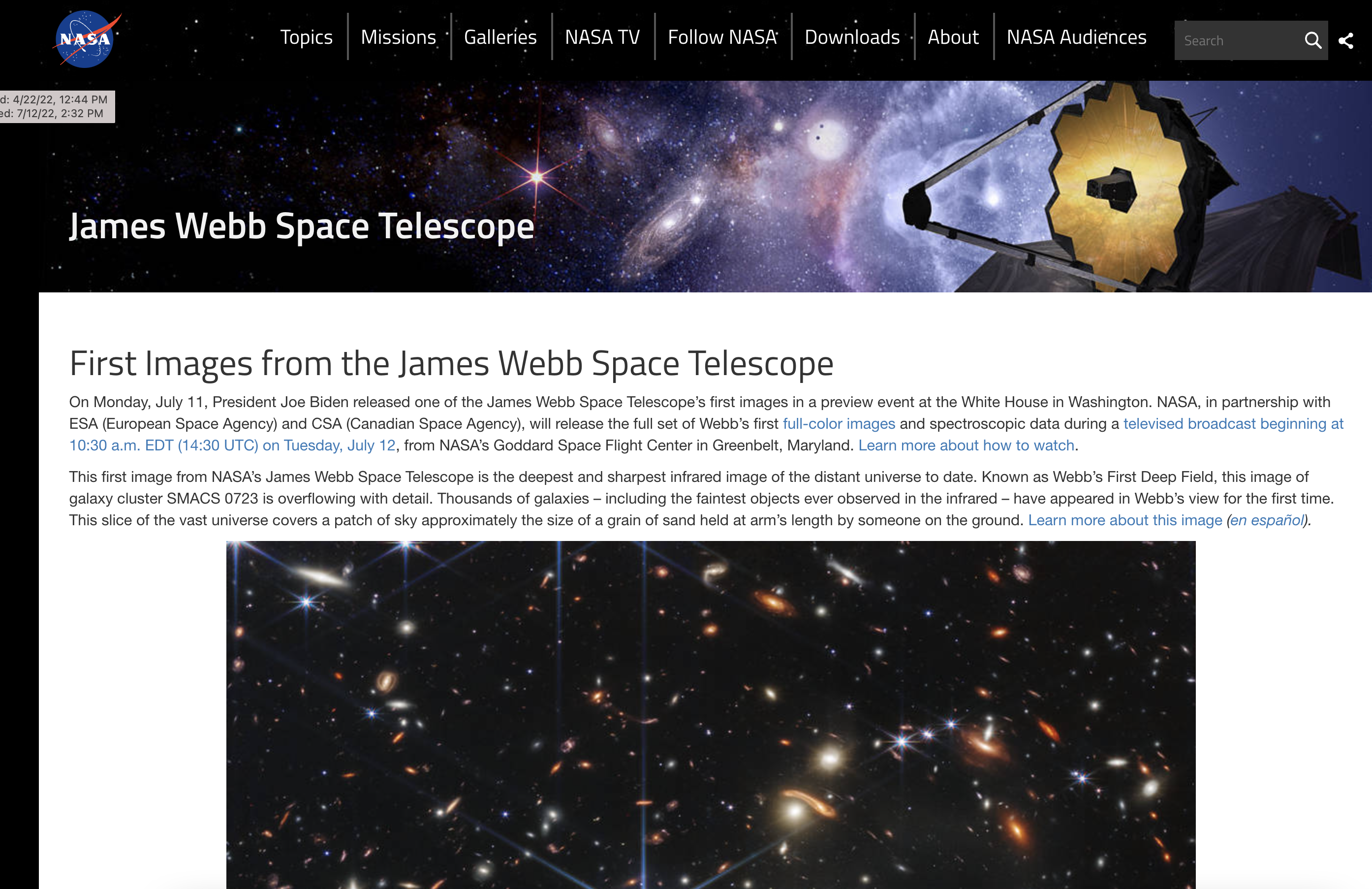
The telescope’s first full-color images will be released one by one and added to this NASA page as they are released so it's worth bookmarking it if you want to keep up to date with things as they happen. Of course, we'll also be gathering a gallery of the most stunning images and exploring what phenomenon they depict.
And we have an official countdown video to the first images from the James Webb Space Telescope! Watch the live broadcast on YouTube below. We'll get the popcorn and put the kettle on...
Over the next 45 minutes or so, NASA Michelle Jones, Chief of Communication at NASA will be presenting a live stream broadcast ahead of the James Webb Space Telescope release – a historic moment.
We're watching it now to find out more about how the Telescope came about as an international collaboration led by NASA, partnered with the European Space Agency and the Canadian Space Agency.
39 minutes to go! Are you excited?
Do you think the JWSP is a giant waste of money or the most fantastic feat of human engineering, knowledge and inspiration ever created?
2 minutes, folks! We've got some lift music to listen to for now, while we await the live coverage of the release broadcast.
"You've got a front row seat to the cosmos". Wait, why didn't we invest in a better monitor?!
The livestream has now started, which sees Nobel prize winner John Mather telling us more about the project, which started as early as 1995! John apparently got a call from NASA headquarters who asked whether he'd be interested in working on the telescope/mission after his Nobel prize win.
"We have the technology to do it now," says John. "But we had to invent things along the way."
This is the largest, most powerful observatory every put into space, and it's the work of over two decades of work by hundreds of scientists and organizations. It's going to answer some of the biggest questions about our universe ever.
86,850 people around the world are currently watching the live NASA launch on YouTube, and that's just that one stream – we've seen other live videos with 800k! There are bound to be millions of people – scientists, school children, space enthusiasts, astronomers and astrophotographers – tuning in, and it feels amazing to be witnessing what feels like a major part of our human history live.
We're currently looking more deeply at the first James Webb Space Telescope image, and a scientist is explaining what elements can be seen in the image.
"This is the further away galaxy that we have details about. The amazing thing about Webb is the speed at which we can churn out discoveries."
From distant galaxies, we're now going to look at a planet – but not one in a galaxy. Cue our SECOND BIG REVEAL.
We've headed to Canada now, but, oh! There's a bit of a glitch with the livestream, and the signal in Canada!
Now, we want to go out and shoot the night sky!
I don't know about you, but all of this chat about space, the solar system and more is really inspiring us when it comes to taking photographs of the night sky. For that we'll need the best cameras for astrophotography and the best telescopes for astrophotography.
The second James Webb Space Telescope: SMACS 0723
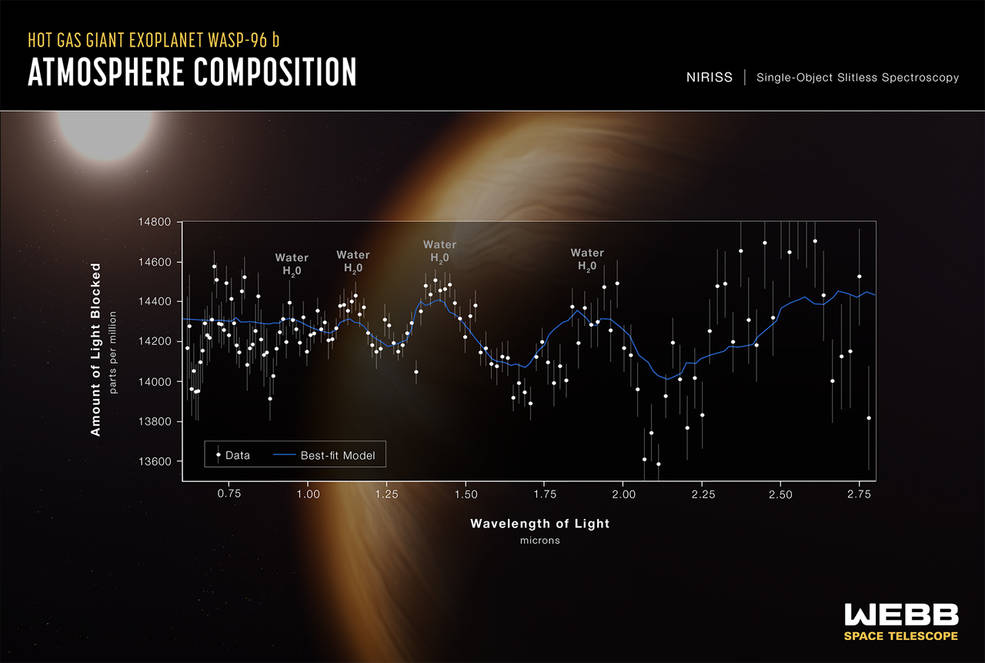
This is the second image released from NASA’s James Webb Space Telescope, and it shows the atmospheric composition of a distant exoplanet, named Wasp 96-b. It shows a signature of water, evidence for clouds and haze in the atmosphere surrounding a hot, puffy gas giant planet orbiting a distant Sun-like star.
Although the Hubble Space Telescope has already analyzed many exoplanet atmospheres in the last twenty years, Webb’s quick and and more detailed observation takes us much closer in the quest to look for planets that might be habitable beyond Earth.
There are three more image reveals to go, but we're going to look at the journey that made the JWST possible, including how the images were processed – not using Lightroom, we're guessing!
"We're translating light that we can't see into light that we can see." The images are colored, using filters that enhance the detail and the structures in the image. The shortest wavelengths of light get assigned blue colors. "There is a lot of aesthetics involved in these images."
The third image from the James Webb Space Telescope
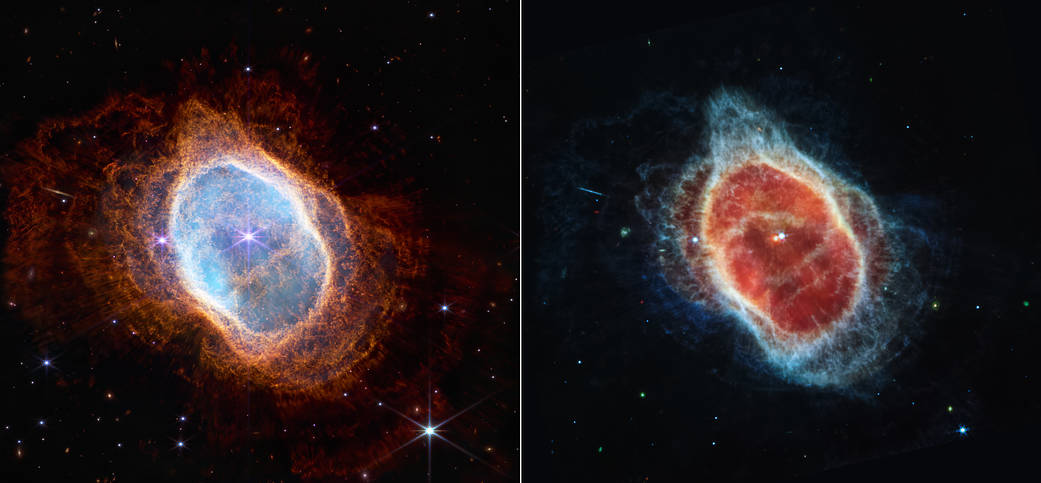
It's image number three from the telescope! We're looking at a planetary nebula, caused by a dying star that has dispelled a large fraction of its mass in successive waves. It's called the Southern Ring Nebula.
NASA explains: "Two cameras aboard Webb captured the latest image of this planetary nebula, cataloged as NGC 3132, and known informally as the Southern Ring Nebula. It is approximately 2,500 light-years away."
Don't forget that you can view Webb's first images on the NASA website. You will need to refresh/reload this page for the images to appear as they are released.
Image 4 from The James Webb Space Telescope
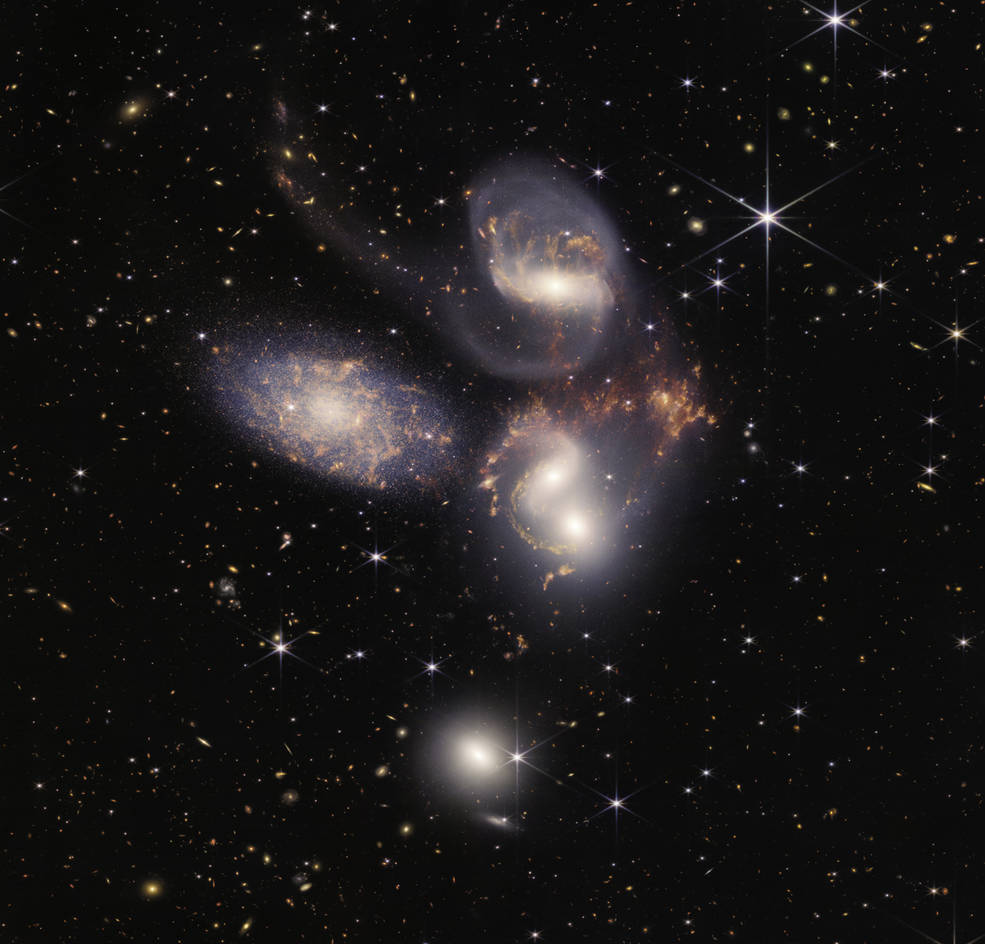
The fourth image is here, folks. It's called Stephan's Quintet, and we are looking at five galaxies – containing millions and billions of stars! It's an image of a cosmic dance, and there's a lot going on in the near-infrared image. But it IS BEAUTIFUL.
NASA adds on the official unveiling: "Stephan’s Quintet, a visual grouping of five galaxies, is best known for being prominently featured in the holiday classic film, “It’s a Wonderful Life.” Today, NASA’s James Webb Space Telescope reveals Stephan’s Quintet in a new light.
"This enormous mosaic is Webb’s largest image to date, covering about one-fifth of the Moon’s diameter. It contains over 150 million pixels and is constructed from almost 1,000 separate image files. The information from Webb provides new insights into how galactic interactions may have driven galaxy evolution in the early universe."
What we're hearing about Webb is several things: "Webb is about all of us," "Webb is for all of us" and "This is just the beginning". What's important to bear in mind is that these images are some of the very first to be processed, so as technology improves we'll be delving into the universe further than ever before.
Image 5 from The James Webb Space Telescope
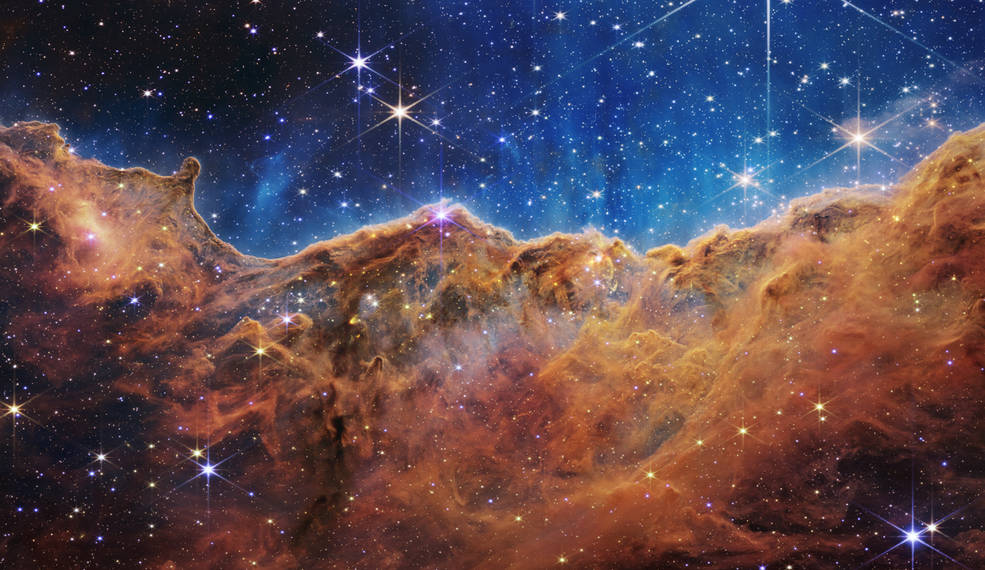
This image of the Carin Nebula is the last to be revealed by NASA on the livestream.
"This landscape of “mountains” and “valleys” speckled with glittering stars is actually the edge of a nearby, young, star-forming region called NGC 3324 in the Carina Nebula. Captured in infrared light by NASA’s new James Webb Space Telescope, this image reveals for the first time previously invisible areas of star birth.
Called the Cosmic Cliffs, Webb’s seemingly three-dimensional picture looks like craggy mountains on a moonlit evening. In reality, it is the edge of the giant, gaseous cavity within NGC 3324, and the tallest “peaks” in this image are about 7 light-years high. The cavernous area has been carved from the nebula by the intense ultraviolet radiation and stellar winds from extremely massive, hot, young stars located in the center of the bubble, above the area shown in this image."
We're wrapping up this livestream soon, but let's think about the point of the James Webb Space Telescope for a moment. It was designed to look at our origins, and it represents the best of NASA, and the ability of science for inspiration.
Several eminent scientists are ending this reveal in a beautiful and profound way.
"We don't ever want to stop exploring the heavens, or to stop taking a step forward for humanity."
"We humans really are connected to the universe. We're made from the same stuff."
Compared to the Hubble Telescope, we're seeing how much more details the James Webb Space Telescope can really "capture". And we can't wait to see even more images revealed over the coming weeks, months and years!
July 12, 2022 marks huge day for science and the imaging of the galaxy!
Get lost in the full-resolution images on NASA's collection of Webb First Images.
